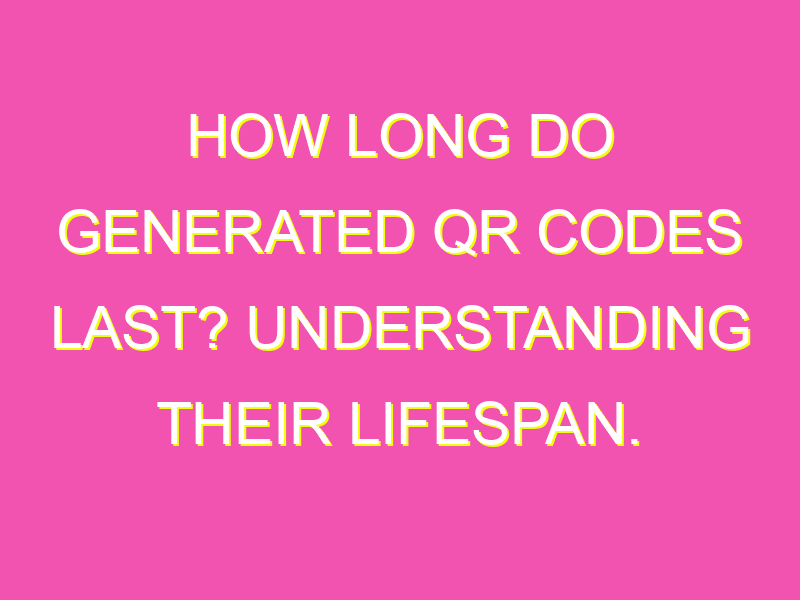QR codes – the digital wonder that makes information sharing so easy and convenient. But have you ever wondered, how long do generated QR codes last? Here’s all you need to know about the lifespan of QR codes.
In conclusion, QR codes’ lifespan is heavily dependent on the type of code, purpose and environmental conditions. Static QR codes are best suited for situations where data is fixed, whereas dynamic QR codes offer the advantage of flexibility and updating data whenever needed. With proper care, QR codes are here to stay, being an essential tool for businesses’ digital marketing campaigns.
Introduction to QR Codes and Their Usage
In today’s world, QR codes have become a common sight everywhere from advertisements to the product packaging that we purchase. QR codes are two-dimensional barcodes that can be scanned using a QR code reader or a mobile scanner app, which directs the user to a webpage or specific information. They are used extensively in marketing, advertising, and retail industry for providing additional information to the customers. QR codes are easy to create, and they offer a convenient, quick and efficient way to encode various types of information.
Understanding Static QR Codes and Their Permanence
While QR codes can contain a vast amount of data in a small, square-shaped block, it also comes with some limitations. There are two types of QR codes, static and dynamic. Static QR codes remain in place after they are created. The information encoded in the QR codes is in place and cannot be edited that is, users are unable to alter them after they print the QR code. In comparison, Dynamic QR codes store the data on servers that can be edited even after the QR code is scanned. Static QR codes, on the other hand, are ideal for situations where the information cannot be changed like QR codes on business cards or packaging.
Situations Where Static QR Codes are Ideal
Static QR codes are ideal for situations where the information needs to be static and unchanged like QR codes on a business card or product packaging, where the information like the company’s contact details or product information doesn’t change frequently. In such cases, Static QR codes offer a permanent and reliable solution to provide the consumer with the necessary information.
Benefits of Using Static QR Codes
1. Reliability and permanence: Static QR codes offer a permanent and unchangeable solution, ensuring that the information remains available to the user at all times.
2. Easy to create: Static QR codes are easy to create, and anyone can create a static QR code for their business, product or services.
3. No need for internet connectivity: Static QR codes can be scanned without an internet connection, and they don’t require a live internet connection to function.
4. High readability: Static QR codes are highly readable, and they can be scanned from a distance or at an awkward angle without any issues.
Limitations of Static QR Codes
While Static QR codes offer many benefits, they come with some limitations as well. Some of the limitations include:
1. No Analytics: Static QR codes lack in-depth analytics, which makes it difficult to track the engagement and user activity.
2. No Editing: Static QR codes offer permanence, but it also means that the information cannot be edited or changed, making them less suitable for dynamic information.
3. Limited data capacity: Static QR codes have limited data capacity, which means they are not suitable for encoding large amounts of data.
How Long Do Static QR Codes Last?
Static QR codes are permanent and offer a reliable way to store unchanging information. The lifespan of the QR code depends on the quality of the code, the material it’s printed on, and environmental factors like humidity and light exposure. A well-created QR code that’s printed on a high-quality surface can last for many years without any issues.
Best Practices for Creating and Using Static QR Codes
1. Use High-Quality QR Code Generators: Use high-quality QR code generators to create static QR codes to ensure they are error-free and read correctly.
2. Test the QR Code: Test the QR code before printing to ensure it works correctly and directs the user to the right webpage.
3. Use the Right Material: Choose the right material for printing the QR code to ensure the durability of the code.
4. Follow Best Design Practices: Follow best design practices, like adding a clear call-to-action, using contrasting colors, and ensuring the size of the QR code is suitable.
Conclusion: Static QR Codes for Reliable, Unchangeable Information
Static QR codes offer a reliable and permanent way to store essential, unchanging information. They are ideal for situations where the data needs to be static and easily accessible like on a business card or product packaging. Static QR codes are easy to create, can be scanned without the need for an internet connection, and offer high readability. It’s essential to follow best practices when creating static QR codes to ensure their longevity and reliability.





